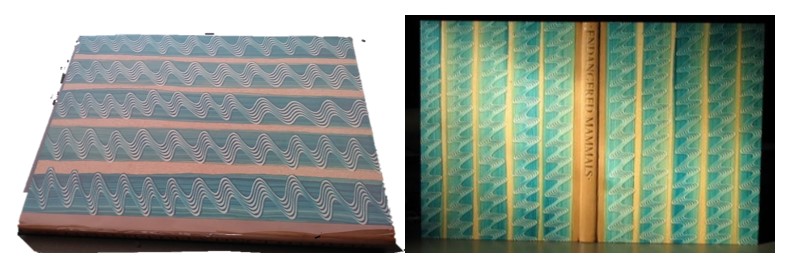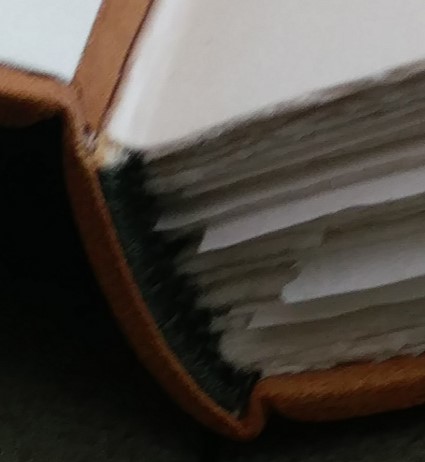Extinction has limited these animals to only being “pets” in the imaginary realm conjured up by the book artist’s printmaking process. I’ve adopted this book for the processes and collaborations that have gone into it’s creation.
First to note is the book’s heft. It is folio size, meaning in bookbinder terms, a full sheet of paper folded once. This meaning may be used differently by bibliographers, as the artist’s book pages are not numbered (verso and recto). The size of the book, as measured by outer covers, is 15.25” x 11.5” and the half-sheet, individual pages are 15” x 11”. Back to the covers: the boards are covered with handmade paste-paint decorated papers which are turned into the inside. The inside of the front and back covers have an off-white paste down, the shade almost matching the printed pages of the book. The weight of the paste down and end papers (3 in front and 5 in the back) is less than the printed the pages, and may be Arches printmaking paper of 115 g/m2.
The binding of the covers is completed with a strip of orangish-tinged-ochre leather forming the book spine and attached to the front and back cover. The leather spine is tooled with the title and letters are in gold leaf. There is a small sticker (0.75” x 0.5”) on the lower left of the final end page which indicates the book was bound by Gray Parrot, of Hancock, Maine. See the image below of the book as in Wesleyan’s Special Collections, and the web-site image from Gray Parrot Press of a similar book binding of the same artist’s work (Alphabet of endangered mammals : a collection of etchings depicting animals considered extinct in the wild 2050, 2010).

Photo of Gaynell’s Pet Book at Wesleyan Special Collections on left, and similar book bound by
Gray Parrot Press on the right (image from their web-site cited below).
The printmaking artist and author of text of both of these books is D.R. Wakefield. My interest in the physicality of artists’ books extends to the hands that engage in tactile arts, and so I find some potentially interesting connections in the narrative of making these books. A visit to their web-sites (http://www.grayparrotbookbinder.com/ and http://chevingtonpress.co.uk/books/ ) reveals that both book binder and printmaker studied under Leonard Bakin. Leonard Baskin is cited to have worked with them both but at different Presses, Mr. Parrot at Gehenna Press and D. R. Wakefield at Eremite Press. This is a story to be filled out another day.
The printmaking paper, mould made, is watermarked as being Somerset. Somerset papers are 100% cotton, “traditional” printmaking paper that comes in 4 surfaces. The surfaces are made by the wool felts used to impress and couch the paper. I believe the surface of this book’s papers are “textured” and described as “..an elegant and hardworking printmaking (paper) perfect for limited editions.” The St Cuthberts Mill web-page presents more interesting information about the making of their papers (https://www.stcuthbertsmill.com/st-cuthberts-mill-paper/somerset-printmaking/#prettyPhoto ). They report using cotton linters “..from the by-product of the textile industry.” as well as other environmentally aware processes. Somerset is a deckle edged paper and made by “..one of the few remaining cylinder mould machines left in the world.” Somerset is a 280 gsm paper and the weight is necessary for the damp working and pressure applied to intaglio, etched prints as in an Alphabet of Extinct Animals.

The above image shows the leather spine of the binding, and the folded folios, with loose tissue papers over each printed page (librarian said the book came with those loose tissues). Also note the deckle edge of printed paper and the turn in of the leather spine and extension onto covers.

The above image, from the St Cuthberts Mill web-page, cited above, shows the plate mark well in the small square, and the varied colors as the sheet is pulled from the inked plate after being pushed through the press.
The following image of a page from An Alphabet of Extinct Animals shows the plate marks, look closely, between the separate plates used for the animal’s name and image. The letterpress text block is below the above 3 plates of word and image.

D.R. Wakefield’s etched prints are rich in color and the pages carry a satisfying platemark, giving the pages an almost sculptural embossing. Only one side of a folded paper is printed, likely a tradition resulting from a deep plate mark in etched intaglio printing. There are indeed 26 extinct animal images, each on their own etching plate. The captions for the images are on a separate etching plate, and the text is letter pressed. The letter pressed text is consistently in black ink. The captioned animal names and animal portraits are colorful, yet with a rich and textured use of black ink creating shadows and lighter hatch marks. Varied shapes of etching plate have been cut for different animals. Four of the pages are folded in, to allow for plates to extend horizontally (those 4 are Audubon Bighorn Sheep, Stellar’s Sea Cow, West Indian Monk Seal, and Yangtze River Dolphin, dimensions in catalog listing). These interspersed fold out pages add to the tactile appeal of this book. Regrettably, my olfactory system allows no report of smell, and the colophon does not include reference to the type of inks used. However, D.R. Wakefield shares in the colophon that the animal images and naming captions were printed “..on a small 19th Century star wheel engraving press and the text, as set by himself, was printed “..on an early Ulmer and Watts Albion Press.” Using such presses requires an embodied capacity and awareness which enriches for me the overall physicality of the book in my hands.
Formal Bibliographic Description
Publisher: Goole, England: The Chevington Press
Publication/Creation: 2009
Physical Description: [3], 30 unnumbered leaves (4 folded in) [5]: ill.; 39 cm (fol.)
Signature Statement: 16 folios, no page numbering
sewn binding seems-to-be over 4 tabs, 2 holes to sew over each tape and 2 holes one at foot and one at head, prob linen thread, thread an off-white color
#14 of signed edition of 55
Material Description: Mouldmade paper with 3 deckle edges per page
pages 15” x 11” except for the 4 fold out pages, of which
2 are 15” x 21” and 2 are 15” x 20”
Covered book boards are 15.25” x 11.5”
Covers are paste papers turn in on back and with a lighter
weight printmaking paper covering inside cover, this same lighter paper is used for the end papers
Sewn binding covered by leather spine with tooled gold leaf letters of the title, bound tooled by Gray Parrot bindery
Language: English
Identifier: OCLC: (OCoLC)464623466
Source: Library Catalog
Collection Path: Collections/SC&A Book Collections/Artists’ books
